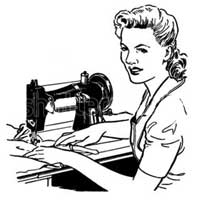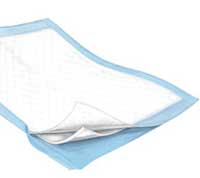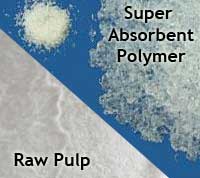Chux Pads - Evolution of the Underpad
Just like facial tissue is commonly called "Kleenex", disposable underpads are commonly called "chux pads" or chux for short. Hospitals have always had a need to absorb body fluids such as blood and urine during surgery. Nursing homes have a higher population of incontinent residents and they needed a way to reduce laundry and remove the urine as well. So how did they deal with it and how did the name chux pads come about? As they say, necessity is the "mother of invention".
 During the 50's and 60's, it was popular for women's volunteer groups to take pages from news paper, tear them into strips or small pieces and sandwich them into full sheets stapled or sewn together around the edges. Nursing homes could absorb the urine and "chuck" it or throw it away. Unfortunately, the ink from the newsprint would get on the skin and make a big mess. Chux pads solved one problem, but created another. To prevent this, Women's groups got the idea that they could take inexpensive sheets of fabric and put the pieces of newsprint inside. This gave convalescent homes a better way to protect beds and chairs from urine. Sometimes, they reused the fabric, replacing the news print each time or eventually quilting scrap pieces of fabric inside and washing the whole pads.
During the 50's and 60's, it was popular for women's volunteer groups to take pages from news paper, tear them into strips or small pieces and sandwich them into full sheets stapled or sewn together around the edges. Nursing homes could absorb the urine and "chuck" it or throw it away. Unfortunately, the ink from the newsprint would get on the skin and make a big mess. Chux pads solved one problem, but created another. To prevent this, Women's groups got the idea that they could take inexpensive sheets of fabric and put the pieces of newsprint inside. This gave convalescent homes a better way to protect beds and chairs from urine. Sometimes, they reused the fabric, replacing the news print each time or eventually quilting scrap pieces of fabric inside and washing the whole pads.
Because incontinence is a widespread and important issue, in the 70's, medical supply manufacturers like Kendall saw that there was a need for a disposable chux pad that would not leak through. The industry came up with the idea to take a layer of blue plastic with multiple layers of white tissue paper on top to protect the bedding and furniture. From this product, three standard size pads evolved: 17x 24, 23x24,and 24x36 inch pads. Chux pads were now commonly referred to as blue pads or blue chux pads. The modern disposable bedpads were born.
 Tissue based blue pads evolved as well. Paper mills like Georgia Pacific decided they could take shredded or recycled paper and place it between the layers of tissue to add absorbency and sell their scrap paper. Because the need for pads was so large, they started to use virgin wood pulp and glued it inside the tissue with thin lines of glue to keep it in place. They started to quilt the chux pads to channel the flow of the urine and keep the contents from shifting. Thin pads and glue created ridges for pressure ulcers to form in a wet environment.
Tissue based blue pads evolved as well. Paper mills like Georgia Pacific decided they could take shredded or recycled paper and place it between the layers of tissue to add absorbency and sell their scrap paper. Because the need for pads was so large, they started to use virgin wood pulp and glued it inside the tissue with thin lines of glue to keep it in place. They started to quilt the chux pads to channel the flow of the urine and keep the contents from shifting. Thin pads and glue created ridges for pressure ulcers to form in a wet environment.
Advances in the textile industry and the desire to keep cost low lead to the creation of washable bedpads made with a vinyl coated barrier to prevent the cloth bedpads from leaking. In a home care setting, the washable pads were generally more cost effective than disposable chux pads. Women's groups and textile manufactures began quilting these washable versions of chux pads. The battle was on.
The creation of poly spun plastics in the 80's have had a huge impact on the production of disposable chux pads. Poly spun top sheets replaced the tissue top sheets because they were tear resistant and allowed fluids to pass through easily into the virgin wood pulp. Chux pads became widely accepted as a better option than cloth due to the benefits of infection control and the convenience of being disposable.
Although modern chux pads and disposable diapers were a great improvement on the thriftiness of women's groups, manufacturers like Procter & Gamble and Kimberly Clark still had to deal with the smell of urine. Nursing homes coped by masking their facilities with fragrance. The new chux pads also created ridges and pools which lead to skin breakdown and the wide use of creams and barriers.
 In the late 80's and early 90's, Super absorbent polymers were introduced to disposable pads, disposable baby diapers, and adult briefs. Super absorbent polymers encapsulated the fluid by binding to the water in urine and changing chemical makeup of urine on a molecular level. This reduced the pH of urine to 7, which inhibited the growth of bacteria, reduced skin breakdown, and eliminated the stench of urine.
In the late 80's and early 90's, Super absorbent polymers were introduced to disposable pads, disposable baby diapers, and adult briefs. Super absorbent polymers encapsulated the fluid by binding to the water in urine and changing chemical makeup of urine on a molecular level. This reduced the pH of urine to 7, which inhibited the growth of bacteria, reduced skin breakdown, and eliminated the stench of urine.
Tranquilty introduced their "peach mat guaranteed" underpads and bladder control pads that had super absorbent polymers laminated to their tissue. While too costly for most health care facilities, their pads have been widely used in home care settings.
First Quality revolutionized the nursing home incontinence market in the 90's with its large scale manufacturing of polymer adult briefs and underpads. Using higher quality polymers and fibers lead to continued improvements in the manufacturing of all adult incontinence products. Large pads with cloth-like poly spun top sheets like Prevail 30x30 underpads now covered more of the bed so that you could use one pad instead of multiple chux pads.
Today's underpads have a host of new features including flaps to hold pads in place, a wide range of sizes and shapes, and moisture-proof back sheets. Medline Ultrasorbs are available with ultra fresh antibacterial technology, bed transfer sheets, and bariatric pads for people up to 600 lbs. Hospitals can even get pads that hold 18 times their weight in fluid and cover an entire table to dispose of after surgery.
Chux Pads have come a long way from the humble beginnings of frugal volunteers and residents in the back rooms of nursing homes. Prevail, Tranquility, and Medline are working on improving them even more every day to enhance patients' lives, keep them at home with their family longer, and make health care facilities run a little more smoothly.